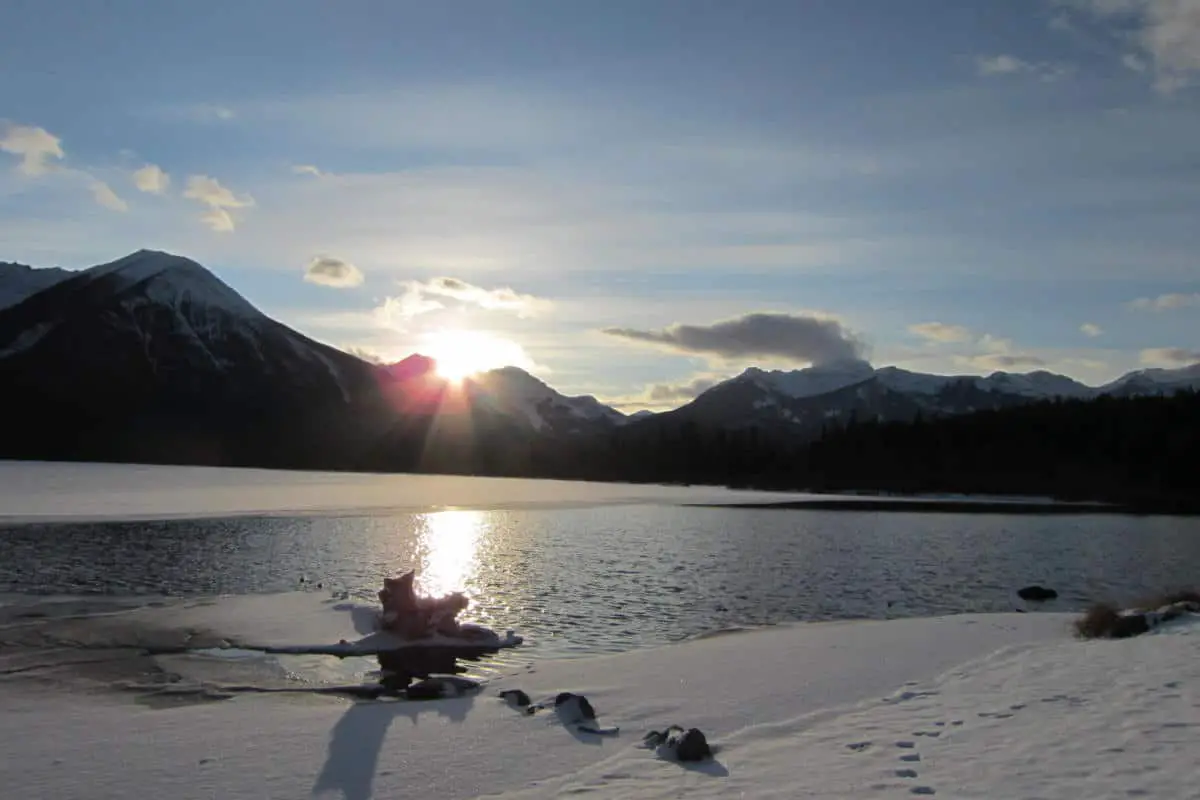With the majestic Canadian Rockies as a backdrop, Banff National Park is hard to beat in winter photography locations. In this overview, I listed the 11 best winter photo opportunities.
First off, you can’t go wrong in Banff regarding searching for photo opportunities. The park is a photographer’s paradise all year round, but winter brings a special kind of magic.
The snow-capped mountains, frozen lakes, and picturesque landscapes make Banff an ideal place to snap some unforgettable winter photos.
So even if you come unprepared, you’ll find plenty of stunning vistas to make your Insta following jealous. So let’s dive into it.
Banff Winter Photos – What’s Different about Them?
When it comes to winter photography in Banff, a few things set it apart from other places. For one, the landscape is blanketed in a thick layer of snow, which can provide a unique and stunning background for your photos.
Additionally, the light tends to be softer and more diffused in winter, creating a beautifully ethereal atmosphere. Finally, the wildlife is more active in winter since there’s much less human activity, so you may have the opportunity to capture some fantastic shots of animals in their natural habitat.
Banff’s Best Winter Photo Locations
As I wrote in the introduction, you don’t actually need to have a list of notable locations to take stunning pictures in Banff. Still, the 11 sites below more or less guarantee you’ll be successful and leave with some mind-blowing material.
1. Sulphur Mountain
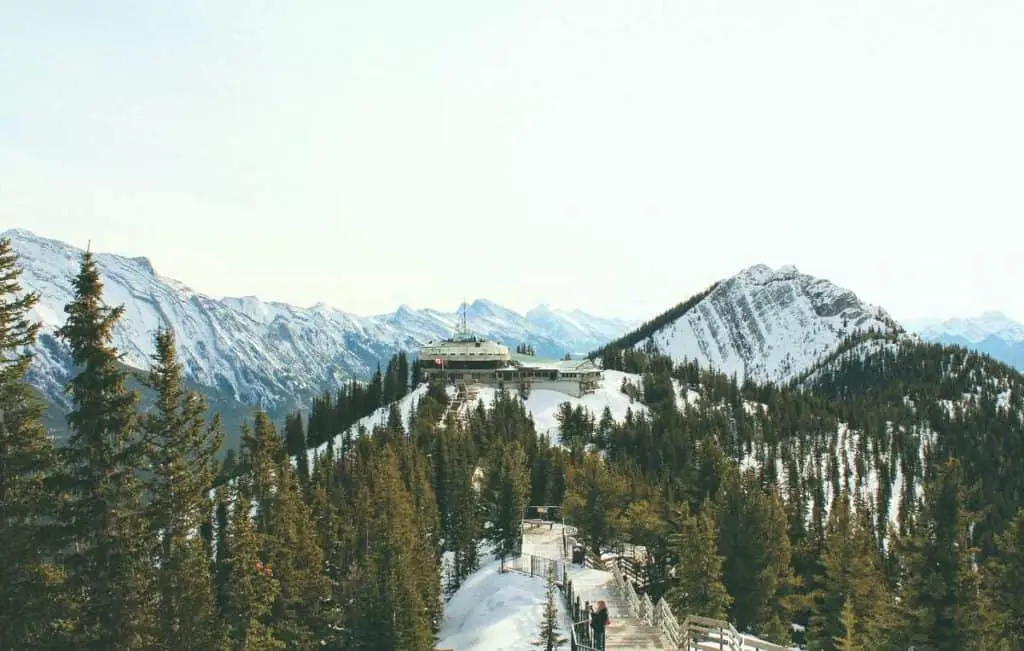
Sulphur Mountain is one of the best places to get a bird’s eye view of Banff. Take the gondola to the top of the mountain, and you’ll be treated to 360-degree views of the stunning landscape.
Allow yourself enough time because the boardwalk on top of the mountain will present you with many spectacular views worth photographing.
2. Bow Falls
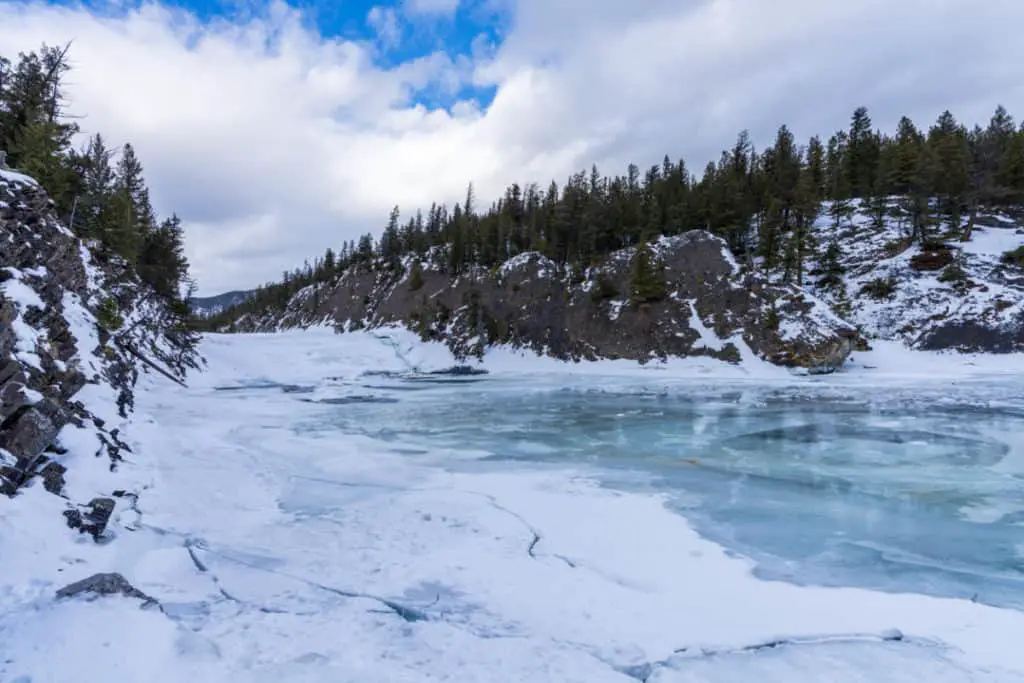
Bow Falls is a beautiful waterfall just a short drive from Banff town, close to the Banff Springs Hotel.
In winter, the waterfall freezes into a column of ice, with only a tiny flowing trickle of water remaining, making it a truly unique sight.
The path along the Bow River allows you to get a birds-eye view of the Bow Falls, providing some interesting perspectives.
3. Surprise Corner
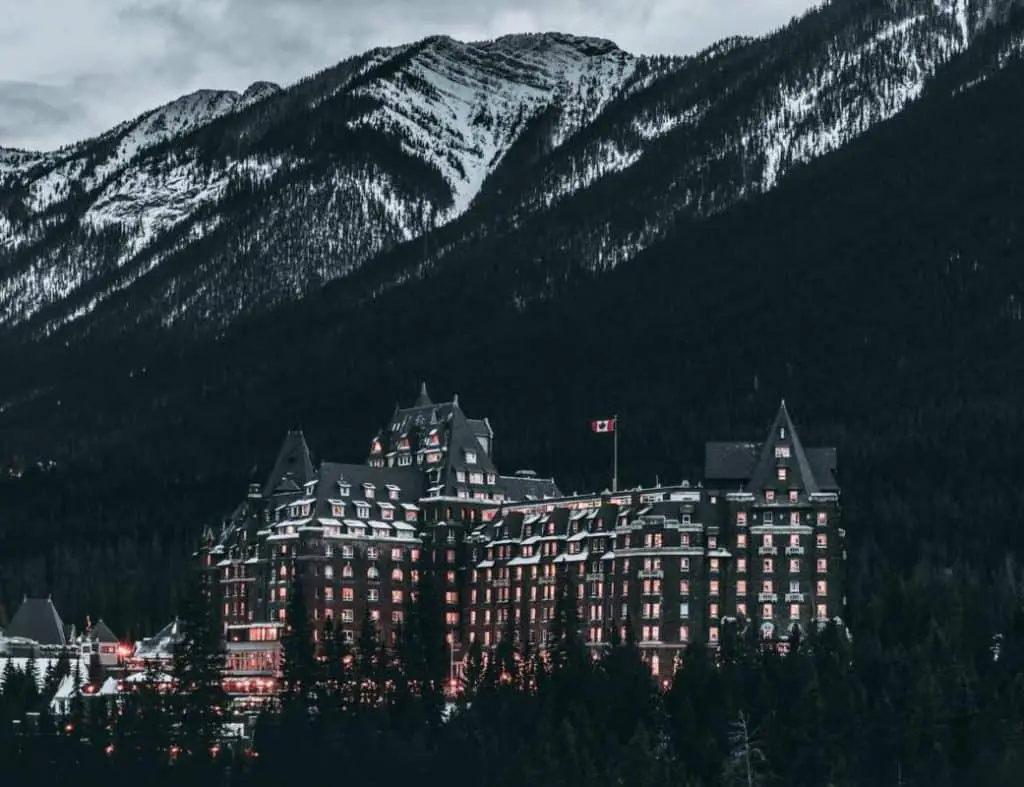
If you want the ultimate winter magic picture, this is it. The Surprise Corner viewpoint offers stunning views of the Fairmont Banff Springs hotel rising above the snow-covered trees on the slope of Sulphur Mountain. This is how you’d picture the perfect Christmas destination. Winter wonderland, indeed.
TIP: If you know low-light photography, try to go there at sunset or in the evening as well. The yellow light of the illuminated hotel windows makes for a truly spectacular shot.
4. Vermilion Lakes

You can never go wrong with Vermilion. Beautiful in summer and winter. It’s interesting to see how different the view becomes in winter, making for entirely different shots. See how the sun reflects on the ice and the majestic Rundle Mountain, sparkling and exciting pics guaranteed!
Cool thing about Vermilion Lakes is that it’s within walking distance of the town of Banff. Though you still might want to go there by car as Banff in winter can get REALLY cold.
5. Two Jack Lake
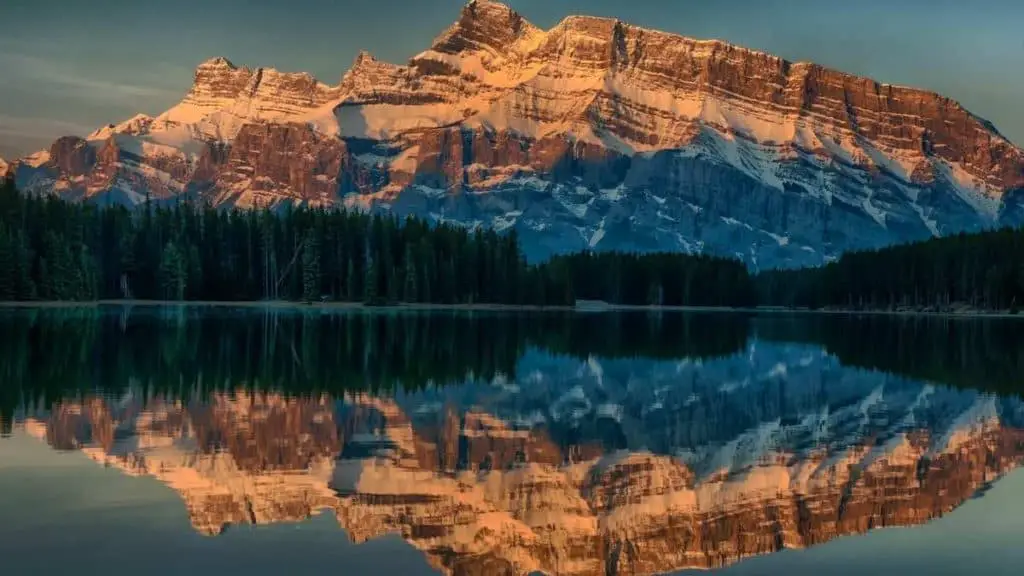
Two Jack Lake makes for a stunning location in winter as well. However, I’d advise you to go there at sunset as it will present you with a marvelous opportunity.
The multi-colored sky behind the mountains makes for a stark contrast with the white and grey world below. Spectacular photos guaranteed!
6. Johnston Canyon
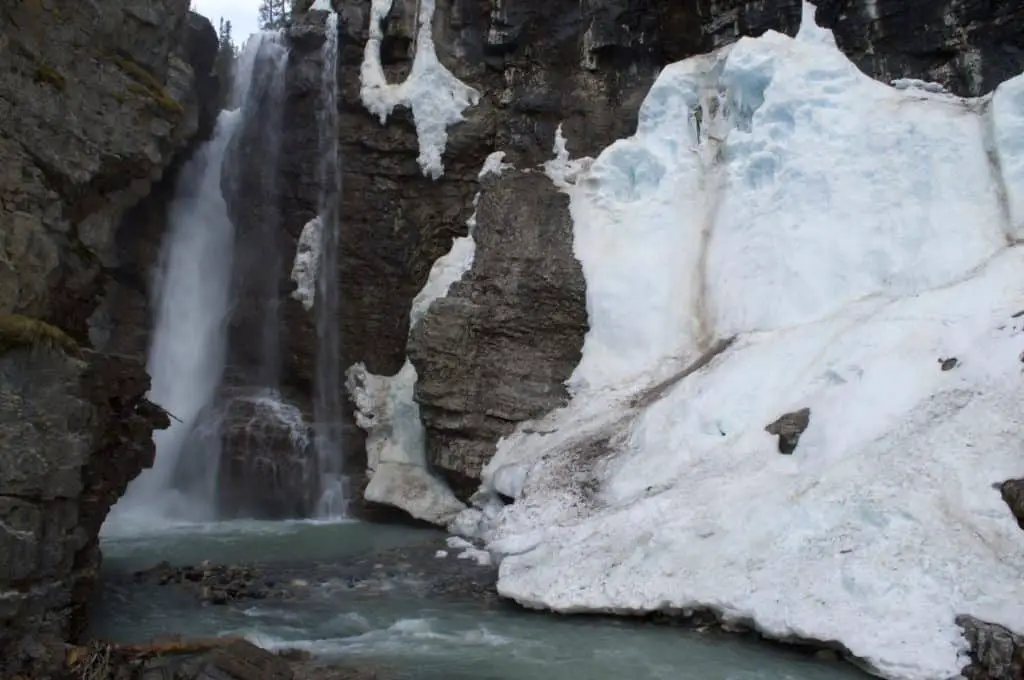
Johnston Canyon is another popular spot for winter photography. The canyon is home to a series of waterfalls that are even more impressive when frozen over.
The canyon itself, with its deep gullies and high rock formations, offers plenty of opportunities for mesmerizing photography!
7. Morant’s Curve
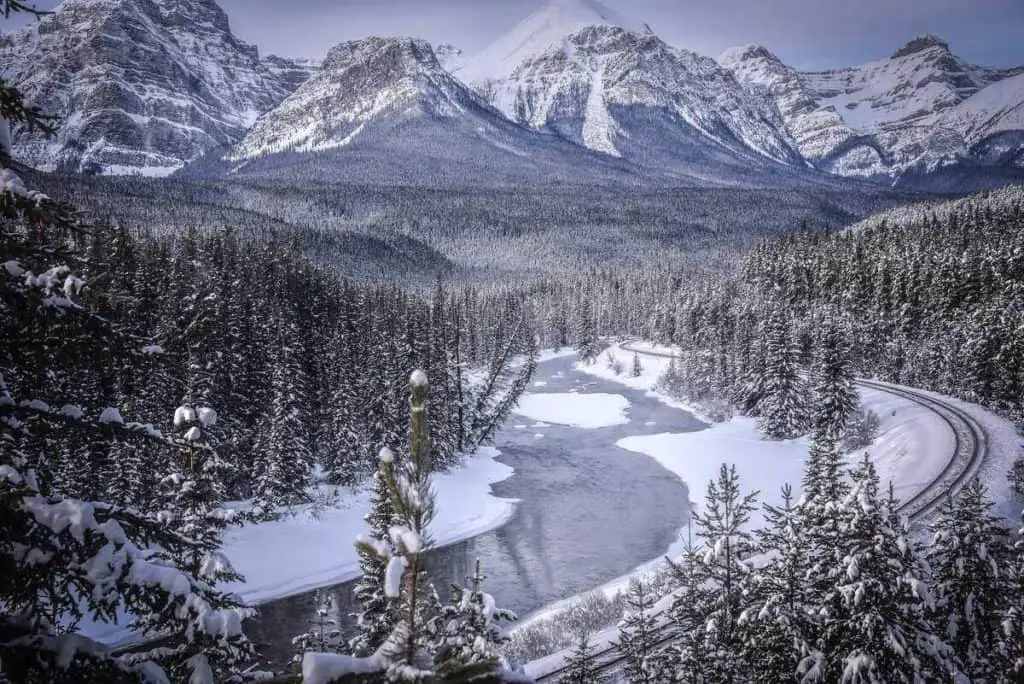
Morant’s Curve is one of the most photographed locations in Banff National Park. However, most photos of this railway bend cutting through the Rockies are taken in summer.
While it’s a stunning scene, the winter variant is just as spectacular. Maybe even better. Because if you have the patience to wait for a train to pass by, you will get an exciting contrast of the colorful train driving through the snow-capped peaks and white forests.
8. Lake Louise
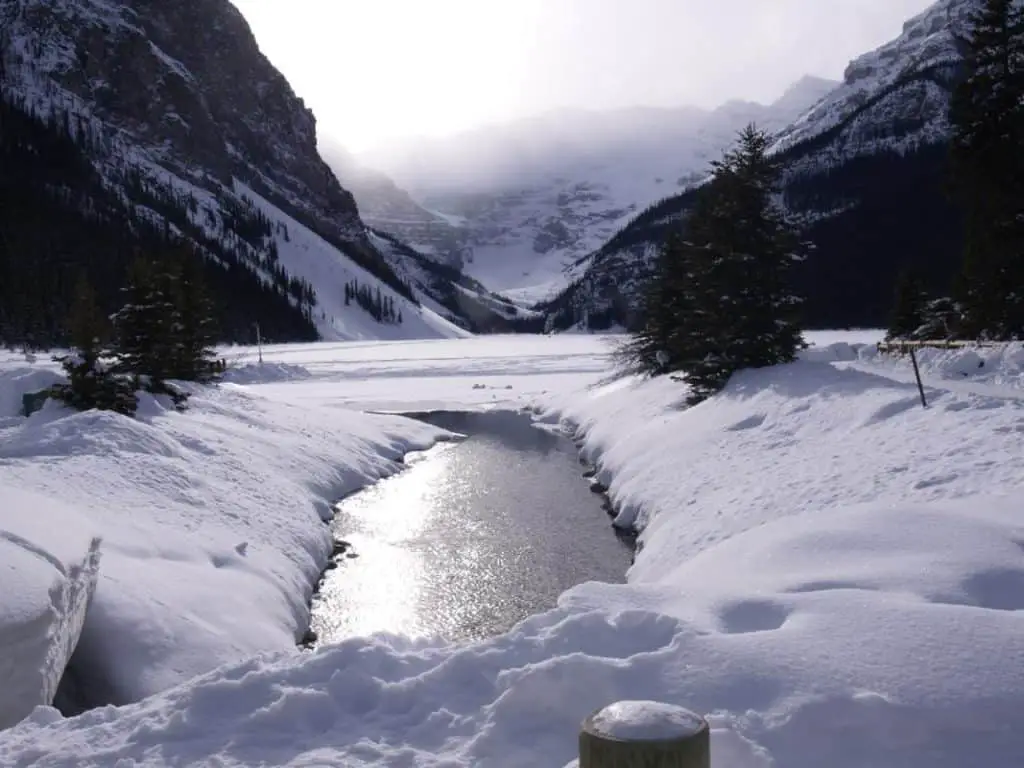
Lake Louise is one of the most iconic places in Banff National Park, and it’s easy to see why. The lake is breathtaking in winter, with the snow-covered mountains looming high above the frozen lake. Be sure to walk out onto it for spectacular views.
9. Moraine Lake
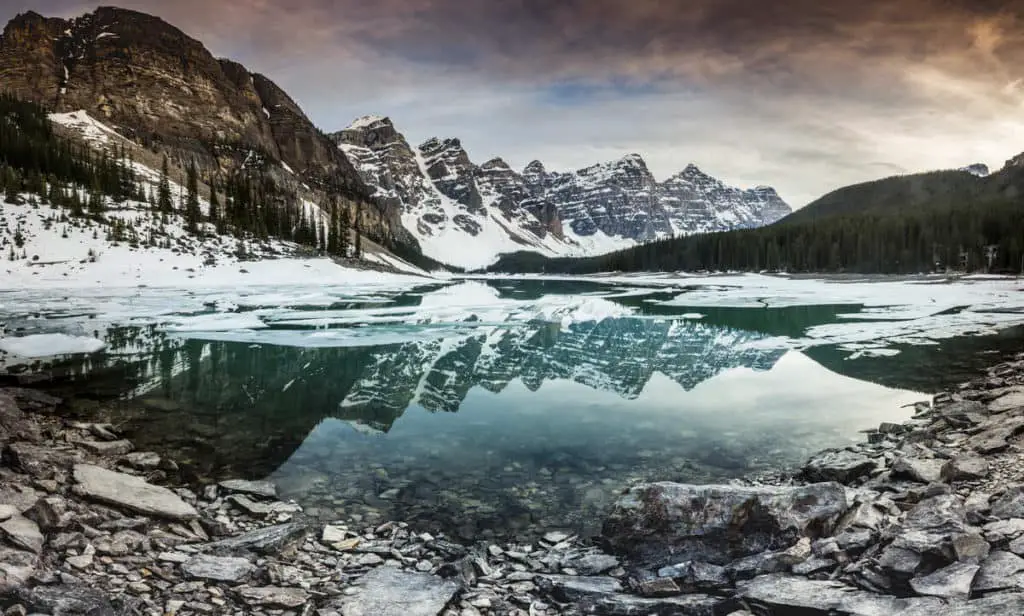
Moraine Lake is another must-see spot in Banff. The lake is small but surrounded by towering mountains, making it look like something out of a postcard. In winter, the whole area is blanketed in snow, making it even more picturesque.
There’s one big but: The road to the lake is closed off in winter due to avalanche danger. As a result, getting there requires walking or cross-country skiing, and it is quite a distance (10 km (6.32 mi)). If that’s not a drawback to you, be sure to educate yourself on avalanches, their risks, and how to avoid them.
10. Bow Lake
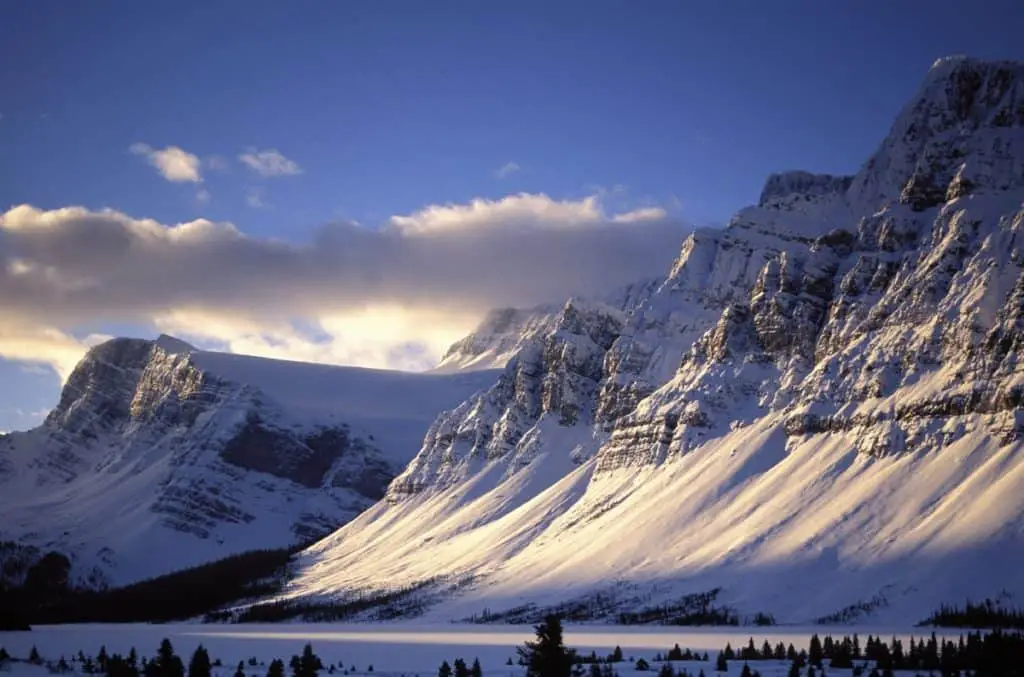
Easy to reach, as Bow Lakes sits right next to the Icefields Parkway, you can take some stunning Insta-magic here. Sure, the lake is frozen in winter, taking away the azure color the lake is known for (like most lakes in Banff, by the way). But the transformation to a snow and ice landscape provides some mystery to Bow Lake that just begs to be photographed.
You may capture breathtaking scenes with the sun reflecting off the snow and ice if you go there on a sunny day (which you, as a photographer, would prefer anyhow).
11. Peyto Lake
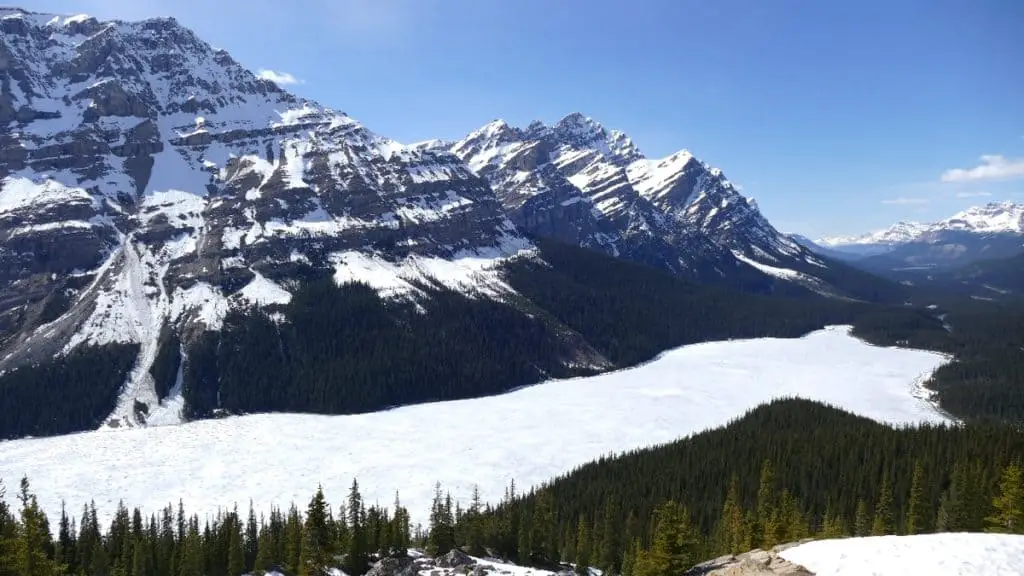
Like Moraine Lake and Lake Louise, going to Peyto Lake for stunning winter photos is obvious. It’s one of Canada’s most beautiful and famous lakes. Peyto Lake never ceases to amaze.
Wintertime offers a different view of “the lake with the fox head,” which is known for its turquoise color in the summer. It’s an incredible opportunity to get a unique image of this renowned lake. Which is also highly gorgeous in winter, mind you.
If you go in early November, you’ll be able to catch the lake that has not frozen yet. The lake’s surrounding mountains and woodlands are blanketed in snow, which creates a beautiful contrast with the lake’s azure water.
How to Get To Your Winter Photo Locations?
Most of the best winter photo spots in Banff National Park are directly accessible by car. Just follow the Trans-Canada Highway westbound from Calgary. It will take you to most of the locations I’ve discussed above.
In the case of Johnston Canyon and Morant’s Curve, you must take the Bow Valley Parkway, easily accessible from the Trans-Canada Highway near Banff.
In the case of Bow Lake and Peyto Lake, you need to drive The Icefields Parkway, which starts at Lake Louise.
The map below will help you find all these locations if you’re unsure where to go. At the bottom of this post you’ll also find a distance table informing you how far and how long you need to travel from Banff and Lake Louise to your next photo opp.
CAVEAT: Before you enter the park, make sure to purchase a Park Pass. You can get one at the park borders. If you want to learn more about it, read the post 20 Things You Need to Know About Banff Park Passes.
What Are the Challenges of Winter Photography?
One of the challenges of winter photography is that the weather can be unpredictable. This means that you might have to deal with snow, wind, or even rain while trying to take pictures.
Another challenge is that the days are shorter in winter, so you’ll have less time to take photos during the day.
How to Prepare for Shooting in Winter?
It’s essential to be prepared when shooting in winter, especially in Banff. Here are a few tips:
- Be aware of the wind chill factor and plan accordingly.
- Keep your camera and lenses warm. Cold can damage your equipment.
- Use tripods and shooting bags to protect your gear from the elements.
- Take extra batteries and memory cards. You don’t want to run out of power or space in the middle of a shoot.
- Be prepared to shoot in low light. Winter days are shorter, and the light can be harsher.
- Check the forecast before you go. You’ll want to know what the weather will be like so you can be prepared.
What to Take With You?
No matter where you go in Banff National Park in the winter, you’re bound to see some breathtaking scenery. To make sure you’re prepared to take advantage of all the photo opportunities, here are a few things to keep in mind:
- Although is very cold in winter, the sun can still be quite intense at high altitudes. Make sure to pack sunscreen and Lip balm to protect your skin.
- A tripod will be your best friend when taking winter photos. The low light and long exposures required for many winter landscapes make handheld photography difficult.
- Don’t forget your camera batteries! The cold can drain them much faster than usual, so it’s always good to have a few spares on hand.
What to Wear?
Winters in Banff can get very cold (think -20˚C or even colder). So if you’re taking photos, you might stand motionless for extended periods. That’s why it’s crucial to dress appropriately.
It is best to dress in layers. Wear a base layer of thermal underwear, followed by a pair of pants and a shirt. Add a sweater or fleece jacket, and top it off with a waterproof and windproof outer layer. You will also want to bring a scarf, gloves, and a hat to complete your outfit.
Distances Table
| DESTINATION | DISTANCE FROM BANFF | DISTANCE FROM LAKE LOUISE | TRAVEL TIME |
|---|---|---|---|
| 1. Sulphur Mountain | 4.5 km (2.8 mi) | 62 km (39 mi) | 8 min / 46 min |
| 2. Bow Falls | 1.6 km (1 mi) | 59.5 km (37 mi) | 4 min / 45 min |
| 3. Surprise Corner VP | 1.7 km (1.06 mi) | 59.6 km (37 mi) | 5 min / 46 min |
| 4. Vermilion Lakes | 2.4 km (1.5 mi) | 58 km (36 mi) | 5 min / 39 min |
| 5. Two Jack Lake | 11.3 km (7 mi) | 68 km (42 mi) | 14 min / 49 min |
| 6. Johnston Canyon | 32 km (20 mi) | 34 km (21 mi) | 32 min / 38 min |
| 7. Morant’s Curve | 69 km (43 mi) | 6.6 km (4.1 mi) | 50 min / 9 min |
| 8. Lake Louise | 61 km (38 mi) | 4.4 km (2.73 mi) | 40 min / 8 min |
| 9. Moraine Lake | 75 km (47 mi) | 18 km (11,18 mi) | 1h4min / 26 min |
| 10. Bow Lake | 101 km (63 mi) | 39 km (24 mi) | 69 min / 29 min |
| 11. Peyto Lake | 108 km (67 mi) | 46 km (29 mi) | 73 min / 33 min |

